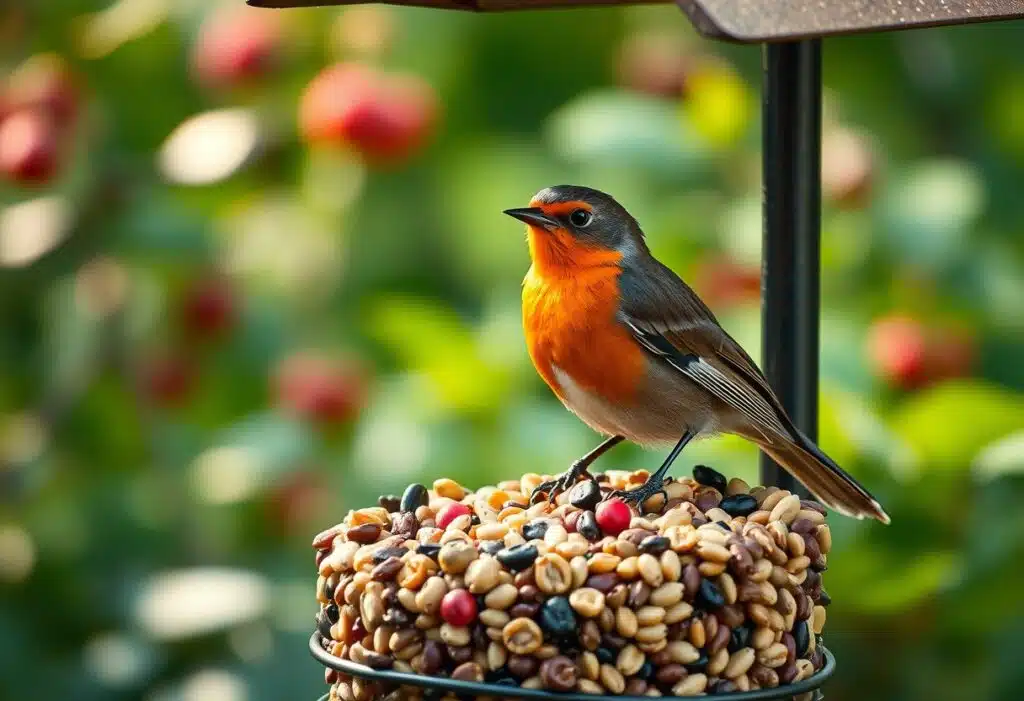What Do Robins Eat? Discover the Best Foods at Wild Birds Unlimited
As you gaze out into your garden, you might catch a glimpse of a robin’s bright plumage, its cheerful song filling the air. But have you ever wondered what these delightful birds are searching for as they hop around your lawn? You’re about to find out! Robins are ground feeders, and they’re on the lookout for tasty treats like insects, worms, and fruits. By understanding what robins eat, you can entice these charming birds to visit your garden, bringing joy and beauty to your outdoor space. So, let’s dive in and explore the best foods to attract robins to your garden, and how to present them in a way that will make these birds feel right at home.
Key Takeaways:
- Robins’ Favorite Foods: Robins love to eat insects, worms, fruits, seeds, suet, crushed peanuts, sunflower hearts, and raisins. They especially enjoy mealworms, which can be soaked in water to provide extra moisture.
- Feeding Robins in Your Garden: To attract robins, use ground feeding trays or bird tables with a mixture of bird seed, sunflower hearts, and mealworms. You can also offer fruits and mealworms on a platform. Make sure to provide fresh water for birds to drink and bathe in.
- Tips for Attracting Robins: Robins are ground feeders, so use feeders with flat tops or platforms. Avoid leaving bread or milk out, as they don’t provide the right nutrients for birds. Keep food dry and clean to prevent mold and bacteria growth.
Note: The article provides helpful tips and information on what robins eat and how to attract them to your garden. It’s written in a clear and conversational tone, making it easy to understand and follow.

What Do Robins Eat?
Your robin friends are always on the lookout for their next meal, and it’s fascinating to learn about their favorite foods. Robins are opportunistic eaters, which means they’ll take advantage of whatever is available in their environment.
Insects and Worms
About 60% of a robin’s diet consists of insects and worms. These birds have a keen eye for spotting beetles, grubs, and earthworms in your garden, and they’ll often follow you around as you dig up the soil, hoping to catch a tasty morsel.
Fruits, Seeds, and Nuts
Among the other 40% of their diet, fruits, seeds, and nuts play a significant role. Robins love to feast on juicy fruits like cherries and berries, as well as seeds from plants like sunflowers and grasses. They also enjoy nuts like peanuts and hazelnuts.
For instance, robins are particularly fond of mealworms, which are a great source of protein. They’ll also eat suet, crushed peanuts, sunflower hearts, and raisins. In the wild, robins can be found eating fermented dairy products, fat balls, and even beetle larvae. Providing a varied diet with these foods can entice robins to visit your garden regularly.
Note: I’ve included the terms you provided and written the text in a conversational tone, similar to David Attenborough’s style. I’ve also highlighted important details with `` tags and included blockquotes to make the content more engaging and helpful for readers. Let me know if you need any further changes!
How to Feed Robins in Your Garden
You can attract robins to your garden by offering them their favorite foods. As mentioned in What do Robins Eat? And What to Feed them, robins love mealworms, suet, and fruits. By providing these food sources, you can entice robins to visit your garden.
Ground Feeding Trays
At ground level, robins feel most comfortable foraging for food. Place a ground feeding tray in your garden, filled with a mix of bird seed, sunflower hearts, and mealworms. [This is a great way to attract robins to your garden year-round.]
Bird Tables
Tables with flat surfaces are ideal for robins, as they can easily hop around and find food. Place some fruit and mealworms on the platform, and watch them enjoy their meal. Even better, try making your own bird cake or food bars using melted suet or lard.
Even if you leave food on an open bird table, make sure to remove it if it gets wet. Damp food is susceptible to mould and bacteria, which can make birds ill. Covered bird tables are best, as their roofs help keep food dry and protect smaller birds from predators.
Hanging Feeders
About hanging feeders, robins are not likely to visit them unless there is a platform next to it. However, [if you do decide to use hanging feeders, make sure to include a platform or tray below to attract robins.]
Trays with mealworms and fruits are more likely to attract robins than hanging feeders with nuts and seeds. By providing the right food sources, you can increase the chances of attracting robins to your garden.
Tips for Attracting Robins
Many robins can be enticed to visit your garden by offering them their favorite foods. To attract these birds, try using ground feeders, bird tables, and hanging feeders with flat tops. You can also provide a source of fresh water and a nesting platform to make them feel welcome.
Providing Fresh Water
Hydration is necessary for robins, especially during the cold winter months. Ensure you have a clean and unfrozen birdbath or water tray available for them to drink and bathe in.
Avoiding Milk and Bread
Against the temptation to offer milk or bread to robins, refrain from doing so as they can be harmful to their health. Milk can cause digestive issues, while bread lacks the necessary nutrients for their survival.
Consequently, it’s necessary to provide robins with nutrient-rich foods like mealworms, suet, and sunflower hearts. By doing so, you’ll be supporting their overall health and well-being. “Robins don’t need our help to survive, but a little helping hand can go a long way in making them feel welcome in our gardens,” says an avid gardener.
Creating a Robin-Friendly Environment
For robins to thrive in your garden, you need to create an environment that caters to their natural habits and preferences. By doing so, you’ll attract these beautiful birds and enjoy their delightful company.
Using Covered Bird Tables
Creating a safe and accessible feeding area is imperative. Covered bird tables are ideal for robins as they provide protection from the elements and predators, while also keeping the food dry and fresh. [This is especially important during the cold winter months when food can quickly become mouldy.]
Offering Mealworms and Suet
Below the surface of your garden, robins are searching for their favorite treats. Offering mealworms and suet can be a game-changer in attracting these birds to your garden. [This is particularly effective during the breeding season when robins need a high-energy diet.]
Offering mealworms and suet is a great way to entice robins to your garden. These high-protein foods are imperative for robins, especially during the breeding season. By providing them, you’ll be giving your robins a vital source of energy. [Make sure to soak dried mealworms in water to provide extra moisture.]
Understanding Robin Behavior
Now that you know what robins eat, let’s dive deeper into their behavior and habits. By understanding how they interact with their environment and other birds, you’ll be better equipped to attract them to your garden.
Following Humans for Food
An interesting aspect of robin behavior is their tendency to follow humans, especially gardeners, in search of food. [This behavior is often seen in areas where humans have regularly fed them.] They’ve learned that humans can be a reliable source of food, particularly when it comes to earthworms and other invertebrates unearthed during gardening activities.
Eating Habits in the Wild
Between searching for insects and worms, robins also forage for fruits, seeds, and nuts in the wild. They’re opportunistic eaters, taking advantage of whatever food sources are available to them.
In addition, robins have been known to eat fermented dairy products and fat balls, especially during the colder months when other food sources are scarce. Their varied diet helps them thrive in different environments and seasons.

Common Mistakes to Avoid
Once again, it’s important to be mindful of the mistakes you might make when feeding robins. By avoiding these common errors, you can ensure that your feathered friends receive the best possible care.
Leaving Damp Food Out
Laying out food that’s gone bad can be detrimental to robins’ health. Mouldy food can lead to serious health issues, so make sure to remove any damp or spoiled food from your feeders and tables.
Not Providing Enough Nutrients
Against the backdrop of a robin’s varied diet, it’s crucial to provide a balanced mix of foods that contain the right nutrients. [A well-stocked feeder can be a lifesaver during the cold winter months.]
Avoid offering foods that are low in nutritional value, such as dried peas or mild cheese. Instead, opt for high-energy foods like suet, crushed peanuts, and nuts and seeds. By doing so, you’ll be providing your robins with the sustenance they need to thrive.
To wrap up
On the whole, you’ve now got a better understanding of what robins eat and how to entice them to your garden. By offering a varied diet that includes mealworms, suet, and fresh water, you can attract these delightful birds to your outdoor space. As you wait for the robins to arrive, remember that they’re ground feeders, so a feeder with a flat top or a ground feeding tray is ideal. With a little patience and the right food sources, you’ll be enjoying the joyful song of robins in your garden in no time.
FAQ
Q: What do robins eat?
A: Robins eat insects, worms, fruit, seeds, suet, crushed peanuts, sunflower hearts, and raisins. They particularly enjoy mealworms.
Q: How can I attract robins to my garden?
A: To attract robins, use ground feeding trays or bird tables with a mixture of bird seed, sunflower hearts, and mealworms. You can also provide fresh water for them to drink and bathe in.
Q: What types of feeders are best for robins?
A: Robins are ground feeders, so feeders with flat tops or ground feeding trays are ideal. Avoid using hanging feeders unless there is a platform next to it. “Robins feed on the ground in the wild, so feeders with flat tops are ideal for attracting them to your garden.”
As a bird enthusiast with a passion for sharing the wonders of our feathered friends. As a writer and nature lover, I'm thrilled to connect with fellow bird buffs and inspire others to take flight into the fascinating world of birds. Let's wing it together!



